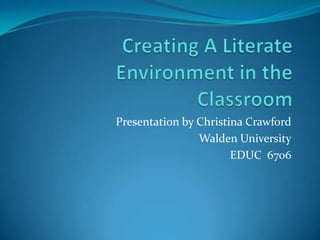
Creating a literate environment in the classroom, P-3
- 1. Creating A Literate Environment in the Classroom Presentation by Christina Crawford Walden University EDUC 6706
- 2. How to Create a Literate Environment Creating an effective literate environment for all of my students is one of my main priorities as a teacher. It is essential in order to create students who are motivated readers and writers. There are several main instructional practices an educator needs to incorporate in order to be successful. These include: Getting to know the students. Assessing students’ cognitive and non-cognitive abilities. Selecting engaging and appropriate texts. Incorporating the three perspectives on literacy learning, interactive, critical and response (Laureate Education, Inc., 2010a) .
- 3. Why is it important to get to know the students? Getting to know students on a deeper level is essential in order to create motivated readers and writers. A student’s attitude toward reading and motivation, or lack there of, are closely related to their level of literacy development. Successful student readers must be motivated, of positive attitude, of good-self concept, and capable of making accurate attributions for their performances (Afflerbach, 2007).
- 4. Getting to Know Literacy Learners Non-cognitive Aspects, P-3 According to Dr. Almasi, we must find out about the whole child, their interests, hobbies, background knowledge, and awareness of who they are as individuals (Laureate Education, Inc., 2010a). Researched based practices I conduct to assess the non-cognitive aspects of students are:
- 5. Getting to Know Literacy Learners Cognitive Aspects, P-3 Assessments used to learn about the students’ skills, strategies, and literacy developmentlevel are:
- 6. Selecting Texts Selecting engaging and appropriate leveled texts for students is extremely important. Text which is too easy or too difficult will not benefit the students (Fielding, 1990). In addition, students need to be provided sufficient background knowledge and taught how to read informational texts. Because of this, I use “twin texts” which is combining nonfiction and fiction texts when teaching lessons (Camp, 2000). According to Camp (2000), twin texts help teachers encourage the enjoyment of reading while capitalizing on students' fascination with facts. For example, if we are learning about insects, we might read a fun story book called Insect Soup (Polisar, 1999) and an interesting non-fiction book called Incredible Insects (Barnes, 2009).
- 7. How to Analyze text with the Literacy Matrix The literacy matrix below is a guide teachers use to analyze and select appropriate texts. The texts are placed in the appropriate quadrants depending on if they're narrative or informational texts. In addition, we analyze if they're more linguistic, which is more word-driven, or semiotic, which includes more pictures than text. From there, teachers examine the dimension of difficulty in another matrix, pictured below on the right, described by Dr. Janice Almasi (Laureate Education, Inc., 2010b). Difficulty is judged by readability (sentence length, number of syllables, concept density, and number of singletons), text length, text structures, size of print, and visual support such as charts and graphs.
- 8. The Three Perspectives There are three main instructional practices that should be implemented after learning about the students and choosing appropriate texts- Interactive, Critical, and Response Perspectives.
- 9. Interactive Perspective The ultimate goal of the interactive perspective is to teach students how to be literate learners who are self-regulating strategic processors (Laureate Education, Inc., 2010b). Reading is a process of creating meaning that involves the reader, a text, and even cultural and social context (Tompkins, 2010). Students create meaning by using skills and strategies. Teaching students comprehension strategies is critical for reading success.
- 10. State and County Standards Addressing the Interactive Perspective State of Georgia Standards The student will use a variety of strategies to gain meaning from grade-level text (ELA2R4) . Gwinnett County Standards The student will make predictions from pictures and titles (GPS) (KLA_B2009-13). The student will identify the main idea and supporting details of literary and informational text read or heard (GPS) (1LA_B2009-14)
- 11. Critical and Response Perspectives One of the most important facets of effective teaching is providing support and regard for students; when a teacher maintains a safe and inviting climate, it is evidence of compassion and concern for the students (Kottler, Zehm, & Kottler, 2005). Students need to feel safe and comfortable in order to take risks and share their thoughts and emotions (Laureate Education, 2010c). This is crucial in order to address the critical and response perspectives.
- 12. State and County Standards Addressing the Critical and Response Perspectives State of Georgia Standards The student will make connections between texts and/or personal experiences (ELA1R6). The student will ask and answer questions about essential narrative elements (e.g., beginning-middle-end, setting, characters, problems, events, resolution) of a read-aloud or independently read text (ELA1R6). Gwinnett County Standards The student will ask and answer questions about essential narrative elements (e.g., beginning-middle- end, setting, characters, problems, events, and resolution) of a read-aloud or independently-read text (GPS) (1LA_B2009-15). The student will compare and contrast content within and between stories and between stories and personal experiences (GPS) (1LA_B2009-17).
- 13. References Afflerbach, P. (2007). Understanding and using reading assessment K–12. Newark, DE: International Reading Association. Barnes, Z. (2009). Incredible insects. Liverpool, United Kingdom: Piatkus Books. Kottler, Zehm, E. Kottler (2005). On Being a Teacher: The Human Dimension. (3rd.ed.)Thousand Oaks, CA: Corwin Press Laureate Education Inc., (2010a). Perspectives on Literacy Learning. The Beginning Reader PreK-3. Baltimore, MD: Author. Laureate Education Inc. (2010b). Analyzing and Selecting Text. [WebCast]. The Beginning Reader PreK- 3. Baltimore, MD: Author. Laureate Education, Inc. (2010c). Response Perspective. The Beginning Reader PreK-3. Baltimore, MD: Author. Polisar, B. (1999). Insect soup. Burtonsville, MD: Rainbow Mornings Music. Tompkins, G. E. (2010). Literacy for the 21st century: A balanced approach (5th ed.). Boston, MA: Allyn & Bacon.